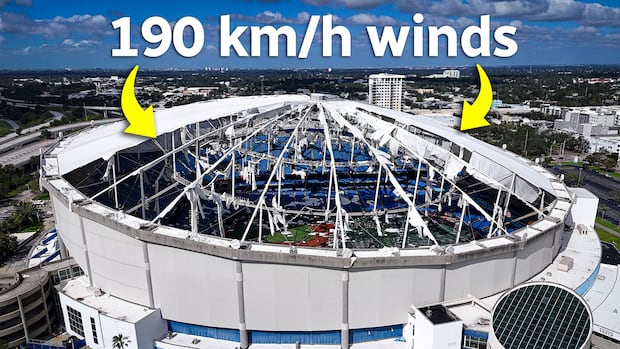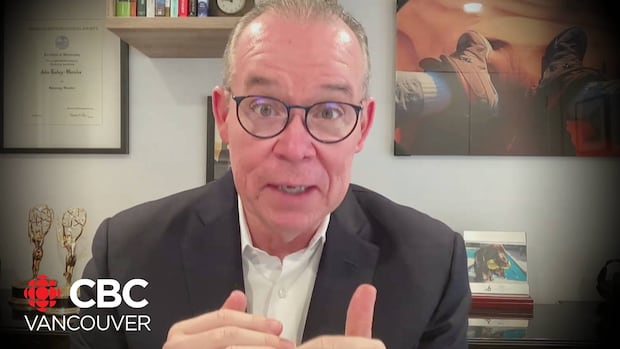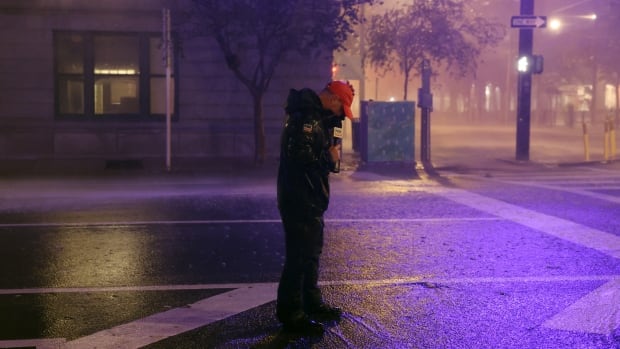
When Anderson Cooper got bonked by flying debris while standing outside in the violent winds and downpour of Hurricane Milton in Florida Wednesday night, it illustrated the potential danger of such on-the-scene storm reporting that has become a journalistic tradition.
Cooper, who was uninjured by the debris, was one of just many reporters braving the elements to cover the hurricane. But that debris incident, and reporting by the CNN journalist and others who venture out in such extreme weather conditions did raise questions about whether such risks are necessary.
Many on social media reposted a video of Cooper being hit by the debris. But as hurricane-force winds whipped around him, some questioned the need for him to be reporting live from Bradenton, Fla., about 35 kilometres north of Siesta Key, where Milton made landfall that evening.
“Does CNN think we won’t believe it’s a bad storm unless they put Anderson Cooper outside?” asked Elizabeth C. Tyler on X, formerly known as Twitter.
CNN’s Anderson Cooper gets smacked in the face by debris as he’s in Bradenton, Florida reporting live on Hurricane Milton, he’s fine <a href=”https://t.co/w3LcKgH5ge”>pic.twitter.com/w3LcKgH5ge</a>
—@Bubblebathgirl
And the professionals are inclined to agree.
“I’ve seen two-by-fours shot through the walls of buildings in these storms,” said Tracy Kijewski-Correa, a professor of engineering at the University of Notre Dame and an expert on disaster risk reduction and civil infrastructure. “That could be Anderson’s body.
At least eight people are dead after Milton smashed through Florida, causing significant damage and leaving millions without power.
‘We gotta go! We gotta go!’
Over at NBC, viewers watched Wednesday as anchor Tom Llamas was forced to flee and take cover as the eye of the storm passed over.
“The situation here in Sarasota is starting to turn dire,” Llamas reported. “At first we had — Oh, we’re going to go. We gotta go! We gotta go! We gotta go!”
This happened when I was live with <a href=”https://twitter.com/GadiNBC?ref_src=twsrc%5Etfw”>@GadiNBC</a> on <a href=”https://twitter.com/NBCNewsNow?ref_src=twsrc%5Etfw”>@NBCNewsNow</a>. Two minutes earlier we were in the eye of <a href=”https://twitter.com/hashtag/milton?src=hash&ref_src=twsrc%5Etfw”>#milton</a>. Completely calm then suddenly the backside of the hurricane hit. A transformer blew behind us. That meant it was time to go in. Everyone okay. <a href=”https://twitter.com/NBCNews?ref_src=twsrc%5Etfw”>@NBCNews</a> <a href=”https://twitter.com/hashtag/sarasota?src=hash&ref_src=twsrc%5Etfw”>#sarasota</a> <a href=”https://t.co/QikOWVsEeg”>pic.twitter.com/QikOWVsEeg</a>
—@LlamasNBC
While recounting the incident later, Llamas said his crew was facing hurricane force winds of 160 km/h. The gusts were so strong that they couldn’t determine the wind strength because he said the gauges they were reading had broken.
Some journalists have defended this kind of reporting as the best way to explain to viewers the dangers a particular storm may pose.
“It is important to show it in factual and vivid terms so people understand just what they are up against,” Dan Shelley, head of the Radio Television Digital News Association, told the Washington Post in 2022.
Hurricane Milton touched down in Florida spawning multiple tornadoes and destroying homes across the state. Andrew Chang breaks down what happened in the 24 hours leading up to Milton making landfall and explains how, despite still leaving a path of destruction, the storm wasn’t as catastrophic as experts had anticipated.
Nora Zimmett, the president of news and original series for The Weather Group, which owns The Weather Channel, has said having meteorologists broadcast live from the field is critical to the channel’s mission of giving people information they need to stay safe.
“It is very hard to do that when you’re showing a static shot that has no context of how conditions of wind and water can affect a human being,” she told the New York Times in 2022.
“Without the context of a human being in the elements, I can tell you, people still don’t understand why they’re being told to leave.”
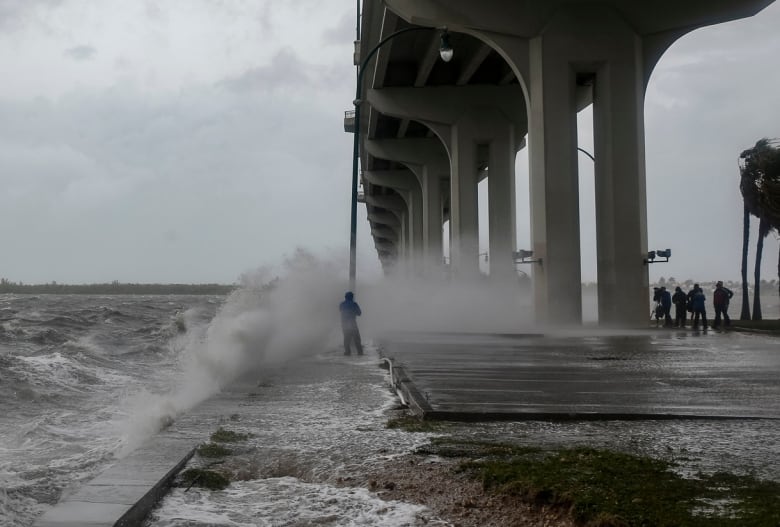
‘No one should be outside at that point’
But Kijewski-Correa says that when winds reach a certain speed, debris can start to move so quickly that it poses a real risk of impalement.
To encapsulate just how dangerous conditions can be for reporters, she said emergency crews won’t respond to 911 calls if winds are over 80 km/h.
“If that is when first responders stop leaving their buildings of safety to go help citizens, then that would be a strong indicator that no one should be outside at that point.”
Jana Houser, a self-described storm chaser and associate professor of meteorology, atmospheric sciences program at The Ohio State University, says there’s really no reason for reporters to be outside like that during a storm.
“You don’t know when the building of the roof next door may come loose and take you out,” she said. “There’s a real threat of harm to a journalist who’s out there covering a storm like that.”
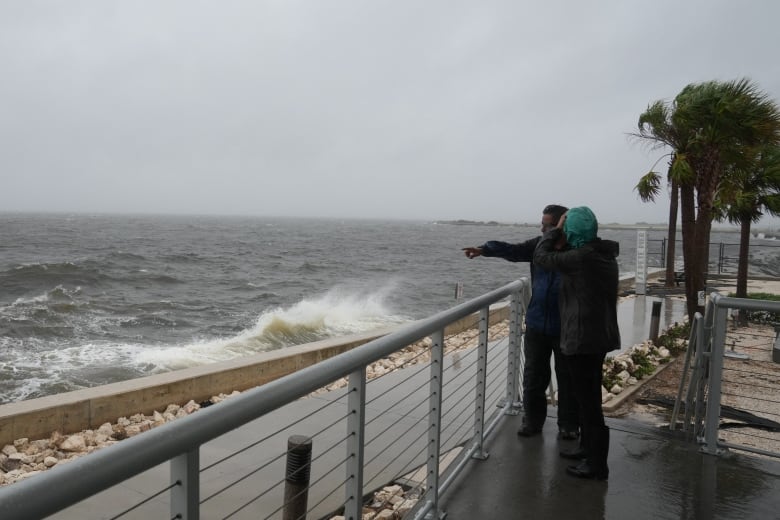
“I don’t think it’s necessarily responsible to get as close as you can possibly get to a location where landfall is occurring,” said Houser, adding that even storm chasers aren’t always able to know what may happen, especially when it comes to things like debris, power polls blowing over, tree branches coming loose and roofs coming off houses.
“All these things are projectiles that can potentially cause harm to somebody nearby,” she said.
Meanwhile, reporters covering such storms have faced close calls, injuries and death.
Jim Cantore literally hit by a flying tree branch during a live report. Please get this man off the street. <a href=”https://t.co/D6UOizGArc”>pic.twitter.com/D6UOizGArc</a>
—@ScottGustin
In 2022, Weather Channel reporter and meteorologist Jim Cantore was struck by a fallen tree branch while reporting in Punta Gorda, Fla., during Hurricane Ian.
Four years earlier, two reporters were crushed to death by a falling tree in North Carolina while covering a storm named Alberto.
Seeing reporters taking shelter more helpful
Kijewski-Correa says that instead of reporters going outside to do live hits during the storm, streaming weather cameras installed throughout a particular region could be used to let people know just how bad the weather is getting.
Someone like Anderson Cooper, she says, would be a more powerful voice if he were to be shown retreating from a storm and taking shelter.
A clip that features Florida meteorologist John Morales becoming emotional while discussing Hurricane Milton has gone viral. Morales says a majority of Americans know climate change is causing extreme weather and more eyes are being opened by events like Milton, which has caused at least five deaths and knocked out power to more than three million homes and businesses in Florida.
“And [explaining] why he’s there and then showing the live feed and [him] saying ‘because I don’t want to be here and nor should you,’ ” Kijewski-Correa said.
“I feel like we should be modelling the behaviour we want to see rather than the sensationalism of the moment.”
